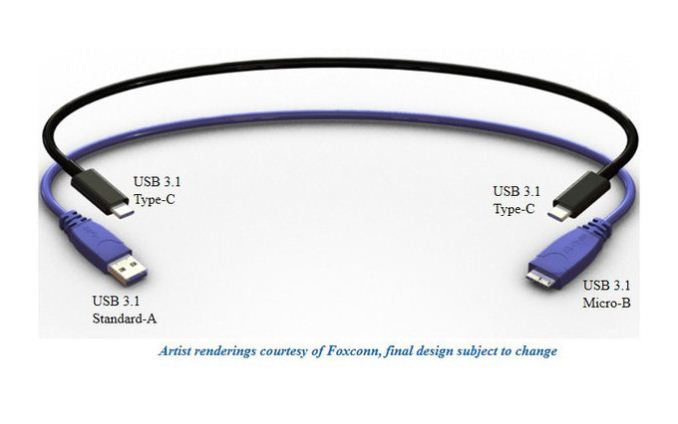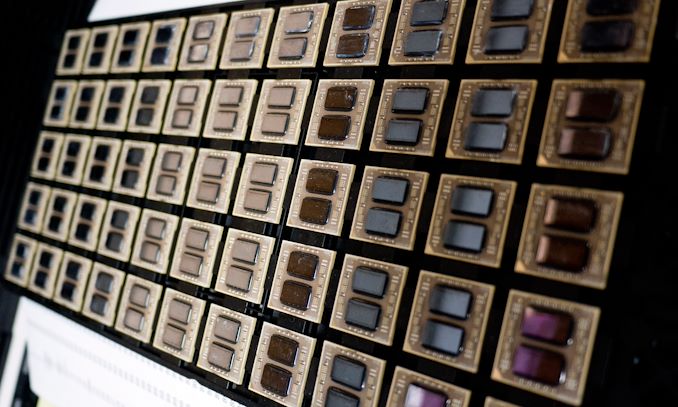
Today it was announced by the USB-IF (USB Implementers Forum) that the latest USB connector which we first caught a glimpse of in April has been finalized, and with this specification many of the issues with USB as a connector should be corrected. USB, or Universal Serial Bus, has been with us for a long time now, with the standard first being adopted in 1996. At the time, it seemed very fast at up to 12 Mbps, and the connector form factor was not an issue on the large desktop PCs of the day, but over the years, the specifications for USB have been updated several times, and the connectors have also been updated to fit new form factor devices.
In the early ‘90s, when USB was first being developed, the designers had no idea just how universal it would become. The first connectors, USB-A and USB-B, were not only massive in size, but the connection itself was only ever intended to provide power at a low draw of 100 mA. As USB evolved, those limitations were some of the first to go.
First, the mini connectors were introduced, which, at approximately 3 mm x 7 mm, were significantly smaller than the original connector, but other than the smaller size they didn’t correct every issue with the initial connectors. For instance, they still had a connector which had to be oriented a certain way in order to be plugged in. As some people know, it can take several tries to get a USB cable to connect, and has resulted in more than a few jokes being made about it. The smaller size did allow USB to be used on a much different class of device than the original connector, with widespread adoption of the mini connectors on everything from digital cameras to Harmony remotes to PDAs of the day.
 USB Cables and Connectors – Image Source Viljo Viitanen
USB Cables and Connectors – Image Source Viljo Viitanen
In January 2007, the Micro-USB connector was announced by the USB-IF, and with this change, USB now had the opportunity to become ubiquitous on smartphones and other such devices. Not only was the connector smaller and thinner, but the maximum charging rate was increased to up to 1.8 A for pins 1 and 5. The connection is also rated for at least 10,000 connect-disconnect cycles, which is much higher than the original USB specification of 1,500 cycles, and 5,000 for the Mini specification. However once again, the Micro-USB connector did not solve every issue with USB as a connector. Again, the cable was not reversible, so the cable must be oriented in the proper direction prior to insertion, and with USB 3.0 being standardized in 2008, the Micro connector could not support USB 3.0 speeds, and therefore a USB 3.0 Micro-B connector was created. While just as thin as the standard connector, it adds an additional five pins beside the standard pins making it a very wide connection.
- How to build a website with WordPress and what are the best plugins to use: Building a website with WordPress is an excellent choice due to its versatility, ease of use, and a vast array of plugins that enhance functionality. Here’s a comprehensive guide to building a WordPress website, along with recommendations for the best plugins.
- What does this property buzzword mean and how does it actually work? Gearing simply means borrowing money to buy an asset. Negative gearing can be a tax strategy used by investors and describes when the income (ie, the rent) made from an investment is less than the expenses it incurs, meaning it’s making a loss.
- How to Sell Your Ecommerce Business for the Best Value: Selling an ecommerce business can be a very profitable move. You can use the proceeds to invest in other projects, launch new ecommerce business websites, or even retire. For some startups, selling the business is the end goal. Whether you have a dropshipping website, sell with Amazon FBA, or own a large-scale ecommerce business, there’s an opportunity for you to sell.
- Comprehensive Guide to WordPress Website Development: Developing a WordPress website is a sequential process that requires careful planning, thoughtful execution, and consistent maintenance to ensure it meets the needs of users and achieves its intended goals. This involves a series of clearly defined stages, including planning, designing, content creation, optimisation, and ongoing maintenance.
- Top 10 High-Paying Jobs AI Won’t Replace in 2025: Artificial Intelligence (AI) is revolutionizing industries, automating repetitive tasks, and reshaping the global workforce. Despite its remarkable advancements, certain professions remain beyond AI’s capabilities due to their reliance on uniquely human traits like creativity, empathy, and critical thinking. This case study explores the 10 highest-paying, fastest-growing jobs in 2025 that AI won’t replace, delving into why these roles are indispensable and how they are evolving in an AI-driven world.
- Spill Your Guts: What To Wear To Olivia Rodrigo’s Australian Tour: Never afraid of screaming out all the dark, embarrassing things we’ve all thought before, Rodrigo sings about comparing herself to her boyfriend’s ex-girlfriend. If you want an edgy outfit that mimics the music…
- Top Social Media Plugins for WordPress to Increase Your Sites Reach and Engagement: If you are seeking to enhance your website’s reach and engagement on social media, you have come to the right place. In this article, we will delve into the premier social media plugins tailored for WordPress users. From Social Warfare to Jetpack, these plugins can facilitate seamless sharing of your content across diverse social platforms.Furthermore, we will provide recommendations to optimize your website’s visibility on social media. Keep an eye out for valuable insights!
- How to Change PuTTY’s Appearance: PuTTY is a widely-used SSH and telnet client for Windows and Linux hosting. While its default appearance is functional, you can customise it to improve aesthetics and usability. Below are the steps to modify PuTTY’s appearance, including changing the font, window size, colours, and cursor options.
- What programming languages does vBulletin use?: vBulletin was orginally written in perl and used a flat file database system. However, as sites grew they notice that sites could not cope with a large amounts of traffic. This problem has now been fully rectified when vBulletin was converted to php and a mysql database system.
With that history behind us, we can take a look at the changes which were finalized for the latest connector type. There are a lot of changes coming, with some excellent enhancements:
- Completely new design but with backwards compatibility
- Similar to the size of USB 2.0 Micro-B (standard Smartphone charging cable)
- Slim enough for mobile devices, but robust enough for laptops and tablets
- Reversible plug orientation for ease of connection
- Scalable power charging with connectors being able to supply up to 5 A and cables supporting 3 A for up to 100 watts of power
- Designed for future USB performance requirements
- Certified for USB 3.1 data rates (10 Gbps)
- Receptacle opening: ~8.4 mm x ~2.6 mm
- Durability of 10,000 connect-disconnect cycles
- Improved EMI and RFI mitigation features
With this new design, existing devices won’t be able to mate using the new cables, so for that reason the USB-IF has defined passive cables which will allow older devices to connect to the new connector, or newer devices to connect to the older connectors for backwards compatibility. With the ubiquity of USB, this is clearly important.

There will be a lot of use cases for the new connector, which should only help cement USB as an ongoing standard. 10 Gbps transfer rates should help ensure that the transfer is not bottlenecked by USB, and with the high current draw being specified by connectors, USB may now replace the charging ports on many laptops as well as some tablets that use it now. The feature that will be most helpful to all users though is the reversible plug, which will finally do away with the somewhat annoying connection that has to be done today.

As this is a standard that is just now finalized, it will be some time before we see it in production devcies, but with the universal nature of USB, you can expect it to be very prevalent in upcoming technology in the near future.


